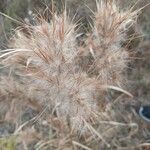Culms tufted, 5–15 dm, branched above, mostly glabrous and often glaucous, the uppermost nodes sometimes sparsely villous; lvs often pilose on the sheath and ligule, the blade 3–8 mm wide; uppermost lvs spathe-like, enclosing the short (2–10 mm) peduncle and base of the few–many paired racemes, these 2–3 cm, with slender, flexuous, long-villous rachis; fertile spikelet 3–5 mm, shorter than the long-villous sterile pedicel, but longer than the internode just above it, the straight awn 1–2 cm; stamen mostly solitary; sterile spikelet none, or a delicate narrow glume to 2 mm; 2n=20. Our two principal vars. are very distinct northward, but pass freely into each other along the coastal plain from Md. southward through a series of intermediate forms often called var. glaucopsis (Elliott) Hitchc. Typical material differs as follows:
Densely tufted perennial; culms erect, 1-1.5 m. high, glabrous; lower leaves crowded in a dense basal cluster, the sheaths flattened, keeled, glabrous, or some-what hirsute at the summit, the blades elongate, 2-4 mm. wide, the upper surface scabrous, more or less villous toward the base; culm sheaths much shorter than the internodes; ligule about 0.5 mm. long, minutely ciliate; flowering branches from the middle and upper nodes forming a loose inflorescence nearly half the length of the culms; racemes paired, slender, flexuous, partly enclosed in the broad conspicuous spathes, the rachis and sterile pedicels villous with long slender white hairs; sessile spikelet 3-4 mm. long, bearing a straight slender awn 10-15 mm. long; first glume acuminate, scabrous on the keels near the summit.


